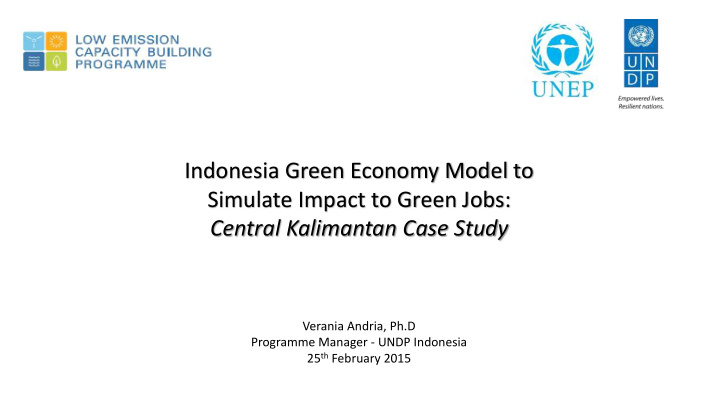



Indonesia Green Economy Model to Simulate Impact to Green Jobs: Central Kalimantan Case Study Verania Andria, Ph.D Programme Manager - UNDP Indonesia 25 th February 2015
Working Definitions and Assumptions • Green Economy is way to ensure sustainable development that is socially just, provides for economic growth and maintains environmental quality . • Indonesia Green Economy Model for Central Kalimantan province (KT-GEM) has been developed by UNDP/UNEP and local government as development planning and monitoring tool to simultaneously simulate the impact of Green Economy policy interventions to social, economic and environment. • Indonesia Green Economy Model introduces following indicators: Green GDP indicator: measures GDP growth that accounts natural capital destruction and depletion; GDP of the Poor indicator: measures the proportion of income of poor households derived from ecosystem services in light of their proportionally higher reliance on these services; Green Jobs indicator: measures job creation in sectors that contribute to reduce negative environmental impact (green sectors). • Green Job is any decent job that contributes to preserving or restoring the quality of the environment whether it is in agriculture, industry, services or administration (ILO/UNEP, 2008). • Modeling cannot fully incorporate decency dimension of Green Jobs . Further assessment and stakeholder consultation processes need to be conducted to measure the decency dimension.
Central Kalimantan Green Economy Model (KT-GEM) Development Process Scenario Stakeholder Building consultations Exercise Development KT-GEM Green Model Adoption Economy Verification & Survey HH KT-GEM Expert Team Validation income Development Model User Interface Training (Government& Data University) Collection
Business As Usual (BAU) Scenario in Central Kalimantan BAU: Economy is based on the extraction of natural resources that in long term leads to decrease of natural capital, increase of cultivated land and intensification and lower green jobs.
Green Economy Interventions in Central Kalimantan GE policy scenario: sustainable agriculture in 1 million Ha, increase agricultural productivity, expand plantation, max 2.5 million Ha forest conversion.
Impact of Green Economy Interventions to Green Jobs • Increase green job opportunities in sustainable agriculture – are the jobs decent? • Shifting green jobs opportunity from agriculture to forest sector – are the workers’ skill meet the market needs? • Increase non-cash income of poor households those living depending on the forest ecosystem – which working class will be benefitted ?
Conclusions: • The Indonesia Green Economy Model could provide information on the impact of the Green Economy interventions to the Green Jobs. • The simulation could assist development of Green Jobs strategy in the simulated area. Thank You
Recommend
More recommend